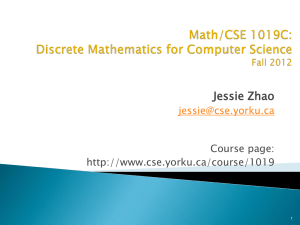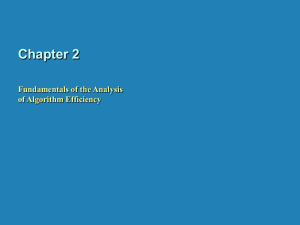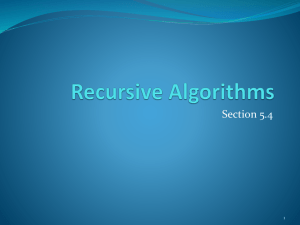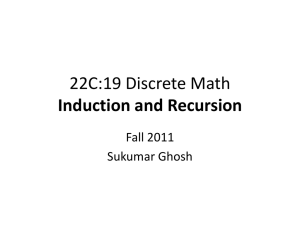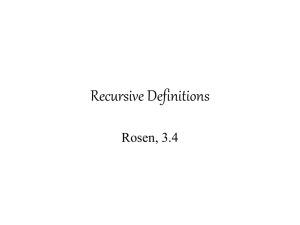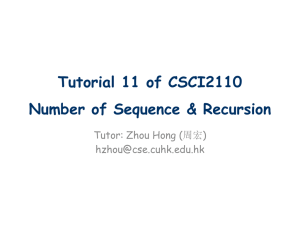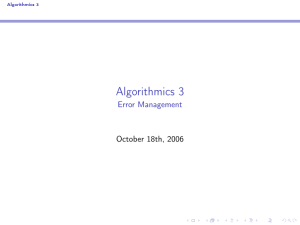slides
advertisement
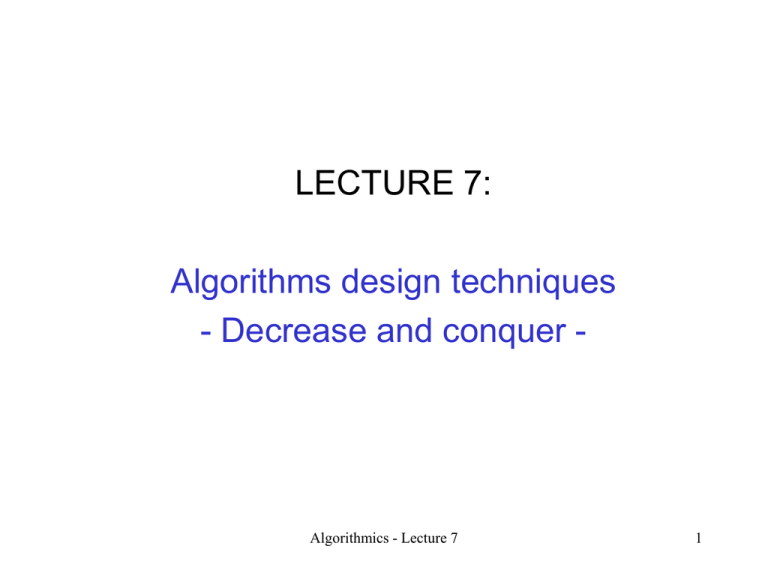
LECTURE 7:
Algorithms design techniques
- Decrease and conquer -
Algorithmics - Lecture 7
1
Outline
• What is an algorithm design technique ?
• Brute force technique
• Decrease-and-conquer technique
• Recursive algorithms and their analysis
• Applications of decrease-and-conquer
Algorithmics - Lecture 7
2
What is an algorithm design technique ?
… it is a general approach to solve problems
algorithmically
… it can be applied to a variety of problems from
different areas of computing
Algorithmics - Lecture 7
3
Why do we need to know such techniques ?
… they provide us guidance in designing
algorithms for new problems
… they represent a collection of tools useful for
applications
Algorithmics - Lecture 7
4
Which are the most used techniques ?
•
Brute force
•
Decrease and conquer
•
Divide and conquer
•
Greedy technique
•
Dynamic programming
•
Backtracking
Algorithmics - Lecture 7
5
Brute force
… it is a straightforward approach to solve a problem, usually directly
based on the problem’s statement
… it is the easiest (and the most intuitive) way for solving a problem
… algorithms designed by brute force are not always efficient
Algorithmics - Lecture 7
6
Brute force
Examples:
•
Compute xn, x is a real number and n a natural number
Idea: xn = x*x*…*x (n times)
Power(x,n)
p←1
FOR i ← 1,n DO
p ← p*x
ENDFOR
RETURN p
Efficiency class
(n)
Algorithmics - Lecture 7
7
Brute force
Examples:
•
Compute n!, n a natural number (n>=1)
Idea: n!=1*2*…*n
Factorial(n)
f←1
FOR i ← 1,n DO
f ← f*i
ENDFOR
RETURN f
Efficiency class
(n)
Algorithmics - Lecture 7
8
Decrease and conquer
Basic idea: exploit the relationship between the solution of a given
instance of a problem and the solution of a smaller instance of the
same problem. By reducing successively the problem’s
dimension we eventually arrive to a particular case which can be
solved directly.
Motivation:
•
such an approach could lead us to an algorithm which is more
efficient than a brute force algorithm
•
sometimes it is easier to describe the solution of a problem by
referring to the solution of a smaller problem than to describe
explicitly the solution
Algorithmics - Lecture 7
9
Decrease and conquer
Example. Let us consider the problem of computing xn for n=2m, m>=1
Since
x*x
if m=1
x2^m=
x2^(m-1)*x2^(m-1) if m>1
It follows that we can compute x2^m by computing:
m=1 => p:=x*x=x2
m=2 => p:=p*p=x2*x2=x4
m=3 => p:=p*p=x4*x4=x8
….
Algorithmics - Lecture 7
10
Decrease and conquer
Power2(x,m)
p ← x*x
FOR i ← 1,m-1 DO
p ← p*p
ENDFOR
RETURN p
Bottom up approach
(start with the smallest
instance of the problem)
Analysis:
a)
Correctness
Loop invariant: p=x2^i
b) Efficiency
(i) problem size: m
(ii) dominant operation: *
T(m) = m
Remark:
m=lg n
Algorithmics - Lecture 7
11
Decrease and conquer
x*x
if m=1
x*x
if n=2
xn/2*xn/2
if n>2
x^n =
x2^m=
x2^(m-1)*x2^(m-1)
if m>1
power3(x,m)
IF m=1 THEN RETURN x*x
ELSE
p ←power3(x,m-1)
RETURN p*p
ENDIF
decrease by a constant
power4(x,n)
IF n=2 THEN RETURN x*x
ELSE
p ← power4(x, n DIV 2)
RETURN p*p
ENDIF
decrease by a constant
factor
Algorithmics - Lecture 7
12
Decrease and conquer
power3(x,m)
IF m=1 THEN RETURN x*x
ELSE
p ← power3(x,m-1)
RETURN p*p
ENDIF
power4(x,n)
IF n=2 THEN RETURN x*x
ELSE
p ← power4(x,n DIV 2)
RETURN p*p
ENDIF
Remarks:
1.
Top-down approach (start with the largest instance of the problem)
2.
Both algorithms are recursive algorithms
Algorithmics - Lecture 7
13
Decrease and conquer
This idea can be extended to the case of an arbitrary value for n:
x*x
x^n= xn/2*xn/2
x(n-1)/2*x(n-1)/2*x
if n=2
if n>2, n is even
if n>2, n is odd
power5(x,n)
IF n=1 THEN RETURN x
ELSE
IF n=2 THEN RETURN x*x
ELSE
p←power5(x,n DIV 2)
IF n MOD 2=0 THEN RETURN p*p
ELSE RETURN p*p*x
ENDIF ENDIF ENDIF Algorithmics - Lecture 7
14
Outline
• What is an algorithm design technique ?
• Brute force technique
• Decrease-and-conquer technique
• Recursive algorithms and their analysis
• Applications of decrease-and-conquer
Algorithmics - Lecture 7
15
Recursive algorithms
Definitions
• Recursive algorithm = an algorithm which contains at least one
recursive call
• Recursive call = call of the same algorithm either directly (algorithm A
calls itself) or indirectly (algorithm A calls algorithm B which calls
algorithm A)
Remarks:
• The cascade of recursive calls is similar to an iterative processing
• Each recursive algorithm must contain a particular case for which it
returns the result without calling itself again
• The recursive algorithms are easy to implement but their
implementation is not always efficient (due to the supplementary
space on the program stack needed to deal with the recursive calls)
Algorithmics - Lecture 7
16
Recursive calls - example
fact(4): stack = [4]
24
fact(3)
4*6
stack = [4]
6
fact(2)
3*2
stack = [3,4]
2
4*fact(3)
fact(3): stack = [3,4]
3*fact(2)
fact(2): stack = [2,3,4]
2*fact(1)
fact(1): stack = [1,2,3,4]
fact(n)
If n<=1 then rez←1
else rez←fact(n-1)*n
endif
return rez
stack = []
fact(4)
2*1
fact(1)
Sequence of
recursive
calls
Algorithmics - Lecture 7
1
Back to
the calling function
17
Recursive algorithms - correctness
Correctness analysis.
to prove that a recursive algorithm is correct it suffices to show that:
– The recurrence relation which describes the relationship between the
solution of the problem and the solution for other instances of the problem
is correct (from a mathematical point of view)
– The algorithm implements in a correct way the recurrence relation
Since the recursive algorithms describe an iterative process the
correctness can be proved by identifying an assertion (similar to a
loop invariant) which has the following properties:
– It is true for the particular case
– It remains true after the recursive call
– For the actual values of the algorithm parameters It implies the
postcondition
Algorithmics - Lecture 7
18
Recursive algorithms-correctness
Example. P: a,b naturals, a<>0; Q: returns gcd(a,b)
Recurrence relation:
a
if b=0
gcd(a,b)=
gcd(b, a MOD b) if b<>0
Invariant property: rez=gcd(a,b)
gcd(a,b)
IF b=0 THEN rez← a
Particular case: b=0 => rez=a=gcd(a,b)
ELSE rez←gcd(b, a MOD b)
ENDIF
After the recursive call: since for b<>0
RETURN rez
gcd(a,b)=gcd(b,a MOD b) it follows
that rez=gcd(a,b)
Postcondition: rez=gcd(a,b) => Q
Algorithmics - Lecture 7
19
Recursive algorithms - efficiency
Steps of efficiency analysis:
• Establish the problem size
• Choose the dominant operation
• Check if the running time depends only on the problem size or also
on the properties of input data (if so, the best case and the worst
case should be analyzed)
(Particular for recursive algorithms)
• Set up a recurrence relation which describes the relation between
the running time corresponding to the problem and that
corresponding to a smaller instance of the problem. Establish the
initial value (based on the particular case)
• Solve the recurrence relation
Algorithmics - Lecture 7
20
Recursive algorithms - efficiency
Remark:
Recurrence
relation
Algorithm design
Recursive
algorithm
Efficiency
analysis
Recurrence
relation
Algorithmics - Lecture 7
21
Recursive algorithms - efficiency
rec_alg (n)
IF n=n0 THEN <P>
ELSE rec_alg(h(n))
ENDIF
The recurrence relation for the
running time is:
c0
if n=n0
T(h(n))+c
if n>n0
T(n)=
Assumptions:
• <P> is a processing step of
constant cost (c0)
• h is a decreasing function
and it exists k such that
h(k)(n)=h(h(…(h(n))…))=n0
• The cost of computing h(n)
is c
Algorithmics - Lecture 7
22
Recursive algorithms - efficiency
Computing n!, n>=1
Recurrence relation:
1
n=1
(n-1)!*n
n>1
Problem dimension: n
Dominant operation: multiplication
Recurrence relation for the running
time:
n!=
0
n=1
T(n-1)+1
n>1
T(n)=
Algorithm:
fact(n)
IF n<=1 THEN RETURN 1
ELSE RETURN fact(n-1)*n
ENDIF
Algorithmics - Lecture 7
23
Recursive algorithms - efficiency
Methods to solve the recurrence relations:
• Forward substitution
– Start from the particular case and construct terms of the
sequence
– Identify a pattern in the sequence and infer the formula of the
general term
– Prove by direct computation or by mathematical induction that
the inferred formula satisfies the recurrence relation
• Backward substitution
– Start from the general case T(n) and replace T(h(n)) with the
right-hand side of the corresponding relation, then replace
T(h(h(n))) and so on, until we arrive to the particular case
– Compute the expression of T(n)
Algorithmics - Lecture 7
24
Recursive algorithms - efficiency
Example: n!
0
n=1
T(n-1)+1
n>1
T(n)=
Forward substitution
T(1)=0
T(2)=1
T(3)=2
….
T(n)=n-1
It satisfies the recurrence
relation
Backward substitution
T(n) =T(n-1)+1
T(n-1)=T(n-2)+1
….
T(2) =T(1)+1
T(1) =0
------------------------- (by adding)
T(n)=n-1
Remark: same efficiency as of the brute force algorithm !
Algorithmics - Lecture 7
25
Recursive algorithms - efficiency
Example: xn, n=2m,
1
n=2
T(n/2)+1
n>2
T(n)=
power4(x,n)
IF n=2 THEN RETURN x*x
ELSE
p:=power4(x,n/2)
RETURN p*p
ENDIF
T(2m) =T(2m-1)+1
T(2m-1) =T(2m-2)+1
….
T(2) =1
------------------------- (by adding)
T(n)=m=lg n
Algorithmics - Lecture 7
26
Recursive algorithms - efficiency
Remark: for this example the decrease and conquer algorithm is
more efficient than the brute force algorithm
Explanation: xn/2 is computed only once. If it would be computed
twice then … it is no more decrease and conquer
.
pow(x,n)
IF n=2 THEN RETURN x*x
ELSE
RETURN pow(x,n/2)*pow(x,n/2)
ENDIF
1
n=2
T(2m) =2T(2m-1)+1
T(2m-1) =2T(2m-2)+1 |*2
T(2m-2) =2T(2m-3)+1 |*22
….
T(2) =1
|*2m-1
------------------------- (by adding)
T(n)=1+2+22+…+2m-1=2m-1= n-1
T(n)=
2T(n/2)+1
n>2
Algorithmics - Lecture 7
27
Outline
•
What is an algorithm design technique ?
•
Brute force
•
Decrease-and-conquer technique
•
Recursive algorithms and their analysis
•
Applications of decrease-and-conquer
Algorithmics - Lecture 7
28
Applications of decrease-and-conquer
Example 1: generating all n! permutations of {1,2,…,n}
Idea: the k! permutations of {1,2,…,k} can be obtained from the (k-1)!
permutations of {1,2,…,k-1} by placing the k-th element
successively on the first position, second position, third position,
… k-th position. Placing k on position i is realized by swapping k
with i.
Algorithmics - Lecture 7
29
Generating permutations
Illustration for n=3 (top-down approach)
123
3↔1
3↔2
321
2↔3
231
321
k=2
123
132
2↔2
k=3
3↔3
3↔1
3 ↔3
2↔1
2↔2
312
132
213
123
recursive call
return
Algorithmics - Lecture 7
30
k=1
Generating permutations
• Let x[1..n] be a global array (accessed by all functions) containing
at the beginning the values (1,2,…,n)
• The algorithm has a formal parameter, k. It is called for k=n.
• The particular case corresponds to k=1, when a permutation is
obtained and it is printed.
Remark: the algorithm
contains k recursive calls
perm(k)
Efficiency analysis:
IF k=1 THEN WRITE x[1..n]
Problem size: k
ELSE
Dominant operation: swap
FOR i←1,k DO
Recurrence relation:
x[i] ↔x[k]
perm(k-1)
0
k= 1
x[i] ↔x[k]
T(k)=
ENDFOR
k(T(k-1)+2) k>1
ENDIF
Algorithmics - Lecture 7
31
Generating permutations
0
k=1
T(k)=
k(T(k-1)+2) k>1
T(k) =k(T(k-1)+2)
T(k-1)=(k-1)(T(k-2)+2) |*k
T(k-2)=(k-2)(T(k-3)+2) |*k*(k-1)
…
T(2) =2(T(1)+2)
|*k*(k-1)*…*3
T(1) =0
|*k*(k-1)*…*3*2
-----------------------------------------------------T(k)=2(k+k(k-1)+ k(k-1)(k-2)+…+k!) =2k!(1/(k-1)!+1/(k-2)!+…+ ½+1)
-> 2e k! (for large values of k). For k=n => T(n) (n!)
Algorithmics - Lecture 7
32
Towers of Hanoi
Hypotheses:
• Let us consider three rods labeled S (source), D (destination) and
I (intermediary).
• Initially on the rod S there are n disks of different sizes in
decreasing order of their size: the largest on the bottom and the
smallest on the top
Goal:
• Move all disks from S to D using (if necessary) the rod I as an
auxiliary
Restriction:
• We can move only one disk at a time
and it is forbidden to place a larger disk
on top of a smaller one
Algorithmics - Lecture 7
33
Towers of Hanoi
Initial configuration
S
I
Algorithmics - Lecture 7
D
34
Towers of Hanoi
Move 1: S->D
S
I
Algorithmics - Lecture 7
D
35
Towers of Hanoi
Move 2: S->I
S
I
Algorithmics - Lecture 7
D
36
Towers of Hanoi
Move 3: D->I
S
I
Algorithmics - Lecture 7
D
37
Towers of Hanoi
Move 4: S->D
S
I
Algorithmics - Lecture 7
D
38
Towers of Hanoi
Move 5: I->S
S
I
Algorithmics - Lecture 7
D
39
Towers of Hanoi
Move 6: I->D
S
I
Algorithmics - Lecture 7
D
40
Towers of Hanoi
Move 7: S->D
S
I
Algorithmics - Lecture 7
D
41
Towers of Hanoi
Idea:
• move (n-1) disks from the rod S to I (using D as auxiliary)
• move the element left on S directly to D
• move the (n-1) disks from the rod I to D (using S as auxiliary)
Algorithm:
hanoi(n,S,D,I)
IF n=1 THEN “move from
S to D”
ELSE hanoi(n-1,S,I,D)
“move from S to D”
hanoi(n-1,I,D,S)
ENDIF
Significance of parameters:
• First parameter: number of disks
to be moved
• Second parameter: source rod
• Third parameter: destination rod
• Fourth parameter: auxiliary rod
Remark:
The algorithm contains 2 recursive
calls
Algorithmics - Lecture 7
42
Towers of Hanoi
Illustration for n=3.
hanoi(3,s,d,i)
s->d
hanoi(2,s,i,d)
hanoi(2,i,d,s)
s->i
hanoi(1,s,d,i)
s->d
i->d
hanoi(1,d,i,s)
d-> i
hanoi(1,i,s,d)
i->s
Algorithmics - Lecture 7
hanoi(1,s,d,i)
s->d
43
Towers of Hanoi
hanoi(n,S,D,I)
IF n=1 THEN “move from S to D”
ELSE hanoi(n-1,S,I,D)
“move from S to D”
hanoi(n-1,I,D,S)
ENDIF
T(n) =2T(n-1)+1
T(n-1)=2T(n-2)+1 |*2
T(n-2)=2T(n-3)+1 |*22
…
T(2) =2T(1)+1 |*2n-2
T(1) =1
|*2n-1
----------------------------------------------
Problem size: n
Dominant operation: move
Recurrence relation:
1
n=1
T(n)=
2T(n-1)+1 n>1
T(n)=1+2+…+2n-1 = 2n -1
T(n)(2n)
Algorithmics - Lecture 7
44
Decrease and conquer variants
• Decrease by a constant
– Example: n! (n!=1
if n=1
n!=(n-1)!*n if n>1)
• Decrease by a constant factor
– Example: xn (xn=x*x
if n=2
xn=xn/2*xn/2 if n>2, n=2m)
• Decrease by a variable
– Example: gcd(a,b) (gcd(a,b)=a
if a=b
gcd(a,b)=gcd(b,a-b) if a>b
gcd(a,b)=gcd(a,b-a) if b>a)
• Decrease by a variable factor
– Example: gcd(a,b) ( gcd(a,b)=a
gcd(a,b)=gcd(b,a MOD b)
Algorithmics - Lecture 7
if b=0
if b<>0)
45
Next lecture will be on …
… divide and conquer
… and its analysis
Algorithmics - Lecture 7
46

